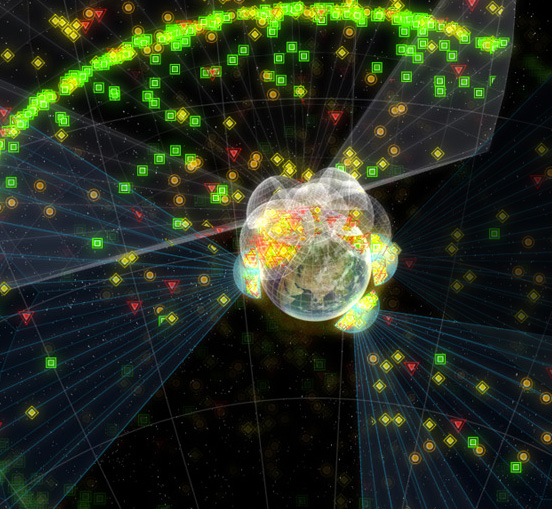Above our heads, 21,000 pieces of man-made junk uncomfortably share the orbit around our planet with satellites, space craft and space platforms. These chunks of orbital debris threaten to collide with all that equipment, potentially bringing down communications, scientific, and military satellites. But if the Air Force has its way, its Space Fence system will track the thousands of pieces of debris and give data to scientists to help them avoid collisions.
This past November, the Air Force’s Electronic Systems Center put out a call for proposals for developing a Space Fence that will use up to three powerful S-band radars to keep track of debris in the southern hemisphere as small as one inch in diameter. These new sensors will compliment the current United States Space Surveillance Network, whose sensors can follow objects down to ten centimeters in diameter.
Orbital debris is everything sent up in space ships that does not return either in the rocket or through gradual reentry into the atmosphere. According to NASA’s Orbital Debris Program website, orbital debris can be derelict spacecraft, intentionally released materials, solid rocket waste, and “tiny flecks of paint released by thermal stress or small particle impacts.” Lower orbit debris that is nearer to the atmosphere may circle the Earth for a few years, but higher orbit debris can stay aloft for centuries.
The Air Force’s current call for proposals is worth up to a total of $214 million for up to two contracts. The contract or contracts will last 18 months and will include preliminary system designs, radar performance tests, and finally actual prototypes. The Air Force estimates that producing the final Space Fence will cost around $3.5 billion dollars. It is scheduled to be operational by 2015.
In 2009, Raytheon Company, Northrop Grumman, and Lockheed Martin completed $30 million worth of studies into the viability of a space fence. In November, Lockheed and Raytheon submitted bids for one of the two $214 million contracts. A Northrop Grumman spokesperson told TPM that they did not plan on bidding.
Chip Eschenfelder, a spokesperson for Lockheed Martin’s Radar Systems operations, said he believed that Lockheed’s history of S-band research would help it produce the final Space Fence. “Lockheed Martin is the world leader in S-band radar development. We have helped outfit over one hundred warships with S-Band radar,” Eschenfelder said. Lockheed Martin has over 400 S-band arrays currently in operation worldwide. You can see Lockheed Martin’s Space Fence website here, and their promotional video embedded at the end of the article.
“These new Space Fence radars will be so precise that they will be able to track an orbiting basketball-size thing traveling at 17,000 miles per hour orbiting the earth,” Eschenfelder said.
Scientists have been warning about the dangers of space debris since the 1970s. But in the last ten years, says Nicholas Johnson (NASA’s Chief Scientist for Orbital Debris), areas of space have reached a critical density of space debris. At low levels of debris, debris naturally is removed by being pulled into the Earth’s atmosphere and burning up. But at higher levels, as debris collides with other debris, more pieces of debris are produced than are filtered out by the atmosphere.
This cascading effect has been exacerbated by recent high profile space collisions. On February 10, 2009 a Russian satellite and an Iridium Communications satellite collided over Siberia. The two satellites collided at 26,170 mph and produced over 1,500 new pieces of debris. In 2007, China also successfully tested an anti-satellite rocket that produced an additional 800-1,000 pieces of debris.
Wouldn’t it make more sense to just remove the pieces of debris instead of spending billions to track it? “That is the sixty-four thousand dollar question,” says NASA’s Johnson. “We’ve been looking at that problem for several decades. We’re still trying to develop a way forward on what technologies and concepts might be the most attractive, but we’re years away from beginning to remove debris.”
President Obama’s National Space Policy published (PDF) this past June, pledged as one of its goal to begin researching ways to remove space debris. “The United States shall … Pursue research and development of technologies and techniques … to mitigate and remove on-orbit debris, reduce hazards, and increase understanding of the current and future debris environment.”









